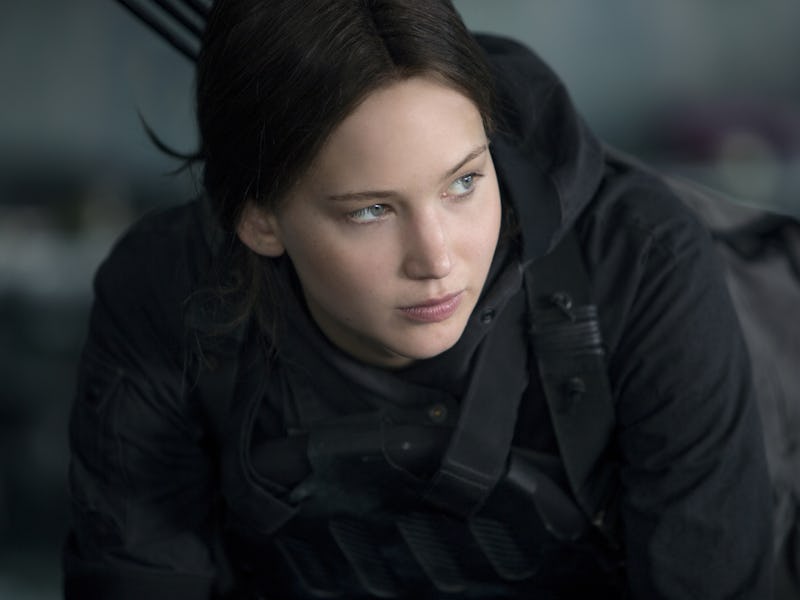10 Years Ago, The Hunger Games Saga Ended On Its Own Depressing Terms
Mockingjay remains a dystopian marvel.

You don’t expect a young-adult novel that depicts a threadbare love triangle with as much gravity as a tense rebellion to end on a feel-bad note. Most YA books, especially those that debuted in the early aughts, used their heightened worlds as a vehicle for romance. Sophisticated sci-fi and fantasy came second.
Suzanne Collins’ Hunger Games saga changed that expectation in the 2010s. On some level, this trilogy is just like its YA contemporaries: Collins’ prose is almost numbingly spartan, and her protagonists are unbearably one-note. The love triangle is also difficult to root for either way you turn (though, let’s be clear, Everlark is the right answer), but the series doggedly commits to the charade to the very end.
What saves the books is the action unfolding around its characters, which gave many a millennial their first taste of truly radical messaing. Collins, the daughter of a Vietnam veteran, understood those traumas and wisely folded them into an impossible dystopian hellscape. The Hunger Games saga turns the violent flash of a Battle Royale into a crusade that never ends, a wicked game in which the rules are always changing. By the time Katniss Everdeen enters the endgame in Mockingjay, she’s fought for her life in two different arenas, and there’s another, even more devastating battle to come.
Mockingjay, the final book in the Hunger Games saga, does not deliver the wholly satisfying conclusion that many fans hoped for. If its predecessors were bleak, the finale cuts even deeper: there is no twist, no reveal, no character’s demise that is off-limits. Mockingjay was a rude awakening for anyone still underestimating the saga’s bracing political message. It doubles down on its nihilist thread, squashing nearly every spark of hope its heroine has left. That the book ends the way it does, leaning more bitter than sweet, was shocking for everyone. That its big-screen adaptation embraced every beat as its own makes it more than a YA sensation, but one of the best dystopian adaptations of all time.
Like so many of the era’s YA juggernauts, Mockingjay was split into two films. Part 1, which debuted in 2014, might be the saga’s quietest chapter, especially after the powder keg that is Catching Fire. After Katniss (Jennifer Lawrence) is pulled out of the 75th Annual Hunger Games — a competition that pitted her against Hunger Games all-stars from every era — she’s forced to face the consequences of her defiance. Her home in District 12 has been razed, and Peeta (Josh Hutcherson), with whom she’s survived two Games, has been captured by the cold-blooded President Snow (Donald Sutherland). Katniss finds herself in District 13, a secret underground city that’s been planning a coup. To save Peeta and stop Snow once and for all, Katniss volunteers to be the face of their revolt.
The first half of Mockingjay slowed things way down before Part 2 delivered a double portion of action.
The first half of Mockingjay follows Katniss as she struggles to become what District 13 needs: a symbol. Defectors from Panem, from the media-savvy Plutarch Heavensbee (Philip Seymour Hoffman) to the film director Cressida (Natalie Dormer), work to mold Katniss into the kind of revolutionary who will unite the fractured districts. That struggle can get tedious, especially with Gale (Liam Hemsworth), the weakest link in the saga’s central love triangle, creeping into the spot where Peeta used to be. But things pick up considerably with Part 2, which hit theaters 10 years ago today and sees Katniss, Peeta, and Gale lead an assault on the Capitol.
It begins in District 2, the last stronghold standing between the rebels and Snow. Brilliantly, the President has turned the entire city into one big arena. Every step seems to trigger a deadly trap, and some new abomination (the Capitol is fond of creating animal hybrids called “mutts”) is lurking in every dark corner. No one is safe in this circus, which makes Mockingjay feel a bit cruel. It’s certainly the most controversial piece of the saga: there are few crowdpleasing moments or moments of levity. It’s a nonstop struggle to the heart of the Capitol, and even when Katniss thinks she’s won, another tragedy springs up to blindside her.
The Hunger Games ended on a bleak note, but that’s what makes this saga so special.
Perversely, though, that’s what makes Mockingjay such a marvel. Collins refused to coddle her audience, a stance that the films (shockingly) upheld. That this blockbuster saga ended with the demise of several fan favorites and committed to a downbeat ending where no one truly wins isn’t so uncommon now, but it felt impossibly rare in the 2010s. Mockingjay brought the Dark Knight trilogy’s sensibility to the YA phenomenon, defying expectations for a trite ending tied in a neat bow. It refused to handle its fans with kid gloves, and that refusal secured this saga’s place in the dystopia hall of fame.